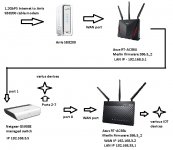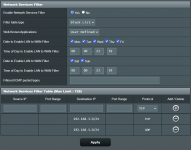Hello everyone,
Need help in setting up a segregated network for IOT devices for the following scenario.
I hope I am posting this in the right part of the forum.
I researched a bit and tried various ways, but does not seem to work in my application.
Would appreciate a guide on how to make this work.
So, basically I have an Arris SB8200 cable modem, which plugs to RT-AC86u WAN port (LAN IP 192.168.3.1 + DHCP pool), which provides wireless and wired access for my home networking devices. One of the LAN ports of AC86u goes into a Netgear GS908E managed switch (port one), it is then distributed to other wired home network devices through ports 2-7. Port 8 goes to AC68u's WAN port (LAN 192.168.33.1 + DHCP pool), which is meant to be used by IOT devices (I have over 70 of them, smart home devices, lights, outlets and etc).
What I am trying to do, is to have AC86u separate from AC68u network, I do not want them to talk to each other. I am trying to set this up in a way, that AC68u only has access to internet and not my local/main (3.1) network.
I tried various ways in the managed switch, (tagged, untagged and etc.), but the AC68u still either has access to my network, or no connection to network or internet at all.
Can this be done without scripting and just utilizing managed switch?
I have guest WiFi network setup in AC68u where most of IOT's connect, they do not seem to be able to access my main network -3.1 (I have "set AP isolated" turned on in AC68u), but all wired IOT's which are connected to AC68u, still are able to access my main network.
The way I am managing AC68u switch is: I have a Windows server 2012 with two ethernet ports, one of the ports is connected to 3.1 network and the other to 33.1. So I RDP in the 2012 server and then manage 33.1 (AC68u) network from there.
I am new to all this, apologies if the above explanation is inadequate.
Thanks in advance
Need help in setting up a segregated network for IOT devices for the following scenario.
I hope I am posting this in the right part of the forum.
I researched a bit and tried various ways, but does not seem to work in my application.
Would appreciate a guide on how to make this work.
So, basically I have an Arris SB8200 cable modem, which plugs to RT-AC86u WAN port (LAN IP 192.168.3.1 + DHCP pool), which provides wireless and wired access for my home networking devices. One of the LAN ports of AC86u goes into a Netgear GS908E managed switch (port one), it is then distributed to other wired home network devices through ports 2-7. Port 8 goes to AC68u's WAN port (LAN 192.168.33.1 + DHCP pool), which is meant to be used by IOT devices (I have over 70 of them, smart home devices, lights, outlets and etc).
What I am trying to do, is to have AC86u separate from AC68u network, I do not want them to talk to each other. I am trying to set this up in a way, that AC68u only has access to internet and not my local/main (3.1) network.
I tried various ways in the managed switch, (tagged, untagged and etc.), but the AC68u still either has access to my network, or no connection to network or internet at all.
Can this be done without scripting and just utilizing managed switch?
I have guest WiFi network setup in AC68u where most of IOT's connect, they do not seem to be able to access my main network -3.1 (I have "set AP isolated" turned on in AC68u), but all wired IOT's which are connected to AC68u, still are able to access my main network.
The way I am managing AC68u switch is: I have a Windows server 2012 with two ethernet ports, one of the ports is connected to 3.1 network and the other to 33.1. So I RDP in the 2012 server and then manage 33.1 (AC68u) network from there.
I am new to all this, apologies if the above explanation is inadequate.
Thanks in advance





